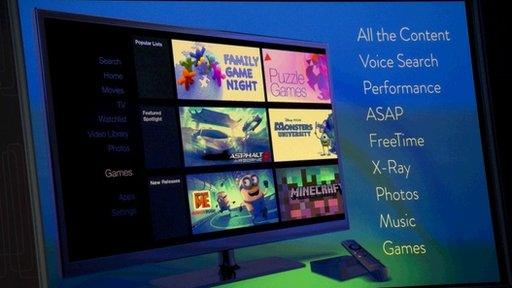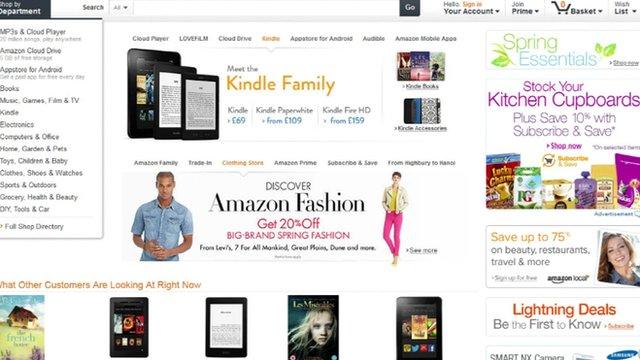Amazon launches TV streaming and gaming device
- Published
Dave Limp, vice president of devices at Amazon: "Fire TV is a great experience for customers"
Amazon has launched an internet-connected TV set-top box as it vies with Apple and Google to gain a share of the lucrative television market.
Dubbed Amazon Fire TV, the device is a small black box similar to Apple TV. It will cost $99 (£59) and is available immediately in the US.
It will allow consumers to stream content from Amazon's library, as well other video-on-demand services, directly to their TVs.
The device can also be used for gaming.
"People play games on tablets but they want to play on TV," said Amazon's Peter Larsen.
The firm has formed partnerships with gaming firms such as Sega, EA, Disney and promises thousands of Android titles will be available next month. It is also expanding Amazon Games Studios to build bespoke games.
Users can buy a games controller, dubbed Voila, which looks very similar to an Xbox controller.
The move puts Amazon in direct competition with Apple TV and Google's Chromecast as all try to find a way into the living room.
The box comes with a Bluetooth-enabled remote, which means it does not have to be pointed at the TV to work.
Despite its ability to stream shows and films from alternatives to Amazon Instant Video - including Hulu, WatchESPN and Netflix - there are some big content providers missing from the list, notably HBO Go.
The BBC's Michelle Fleury tests Amazon's new TV set-top box, Fire TV
Box battle
Currently there are three main ways that consumers can stream video-on-demand services to their TVs:
a dongle
a set-top box
a games console
Roku claims to lead the field when it comes to net-connected set-top boxes.
Meanwhile Apple's figures indicate it shipped about 10 million of its set-top boxes last year, and Google recently entered the fray with a $35 (£21) dongle that plugs into a television's HDMI port and allows users to stream content from smartphones, tablets and computers.

The TV interface also allows users to play games
"Amazon's move is essentially the final piece in a three-way battle between America's internet heavyweights for tomorrow's TV screen," said David Watkins, an analyst with Strategy Analytics.
"It's like Dr Pepper challenging Coke and Pepsi's empire. Apple's there already, Google joined last year, now all will be up against the incumbent pay TV providers.
"To thrive, however, they'll probably have to do partnership deals as Apple has been trying."
Amazon has a lot of its own content to put on such a device though.
"It makes sense for Amazon to try to tie everything in to its eco-system and is the logical next step after the success it has had with the Kindle," said Ovum analyst Jonathan Doran.
Recent research from Consumer Intelligence Research Partners (CIRP) revealed that Kindle owners spent, on average, $443 (£266) a year more than the Amazon shopper who does not own a Kindle.
Now Amazon is looking to do the same with video.
In 2011 Amazon released its Instant Video service, and it has invested huge amounts to create a large catalogue of movies and TV shows. The service is offered to Amazon Prime customers for free instant streaming.
Amazon Prime currently has more than 10 million users worldwide, with the bulk in the US, according to the Strategy Analytics consultancy.
Last month the firm put up the price of Prime from $79 to $99 per year. Subscribers can rent a Kindle e-book each month, access its video library and obtain free one-day shipping on items sold via the Amazon website.
Online viewing
Although it makes sense for companies to gain a share of the on-demand video market it is not always good news for consumers, according to Mr Doran.

A games controller can be used to play titles including Minecraft, Asphalt 8 and The Walking Dead
"There can be too many things to choose from and I have yet to see one device where you can do everything," he said.
"People have to keep chopping and changing between devices to get different content."
The nature of how people view video content was changing, said Jay Fulcher, chief executive of online video tech specialists Ooyala.
"Over a quarter of online video viewing is happening on a mobile or tablet, that platform has become mandatory for content publishers," he said.
"All of the technology companies are building infrastructure to connect to the new economy forming around television so that people can watch what they want, when they want in a seamless way."
- Published2 April 2014

- Published19 March 2014
- Published24 May 2013